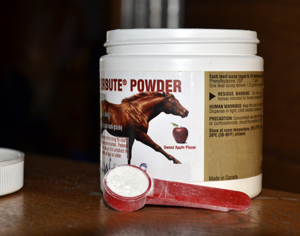March 27, 2012?When it comes to easing lameness, are two drugs better than one? Apparently not, a new study suggests.

Researchers at the University of Illinois College of Veterinary Medicine compared the effects of two common nonsteroidal anti-inflammatory drugs, phenylbutazone and flunixin meglumine (Banamine), used separately and in combination. Many people believe that combining these drugs provides more relief than using either drug alone because the drugs are thought to work synergistically, with flunixin meglumine kicking in faster and phenylbutazone acting longer. But there’s little data on the combined use of these drugs, so veterinarians Jonathan Foreman, an Illinois professor and associate dean, and Rebecca Ruemmler, now of Boston Equine Associates in Rehoboth, Massachusetts, tested the hypothesis.
The research subjects were eight healthy Thoroughbreds outfitted with special heart-bar shoes. Once a week the researchers adjusted the shoes to induce temporary lameness. Then the horses randomly underwent one of four intravenous treatments?a saline placebo, phenylbutazone at a standard dose of 4.4 milligrams per kilogram of body weight (equivalent to two tablets given orally), flunixin meglumine at a standard dose of 1.1 milligrams per kilogram of body weight, or the two drugs combined at the same dosages. The researchers, who never knew which horse received which treatment, monitored the effects over the next 12 hours. At set intervals they repeatedly assessed and scored each horse’s degree of lameness, checked heart rates (as an indicator of discomfort) and drew blood to measure drug concentrations.
The results, presented last fall at the annual convention of the American Association of Equine Practitioners, showed that the combination was no better at relieving acute lameness than either drug alone. Compared to horses given saline, horses given either of the NSAIDs had lower heart rates starting two hours after treatment and lasting at least 10 hours after treatment.
“Stacking,” as the practice of giving a horse multiple NSAIDs is sometimes called, also violates US Equestrian Federation medication rules. Previous research has shown that doubling up on these meds can also trigger serious side effects, including severe gastric ulcers.
This article originally appeared in the April 2012 issue of Practical Horseman magazine.









